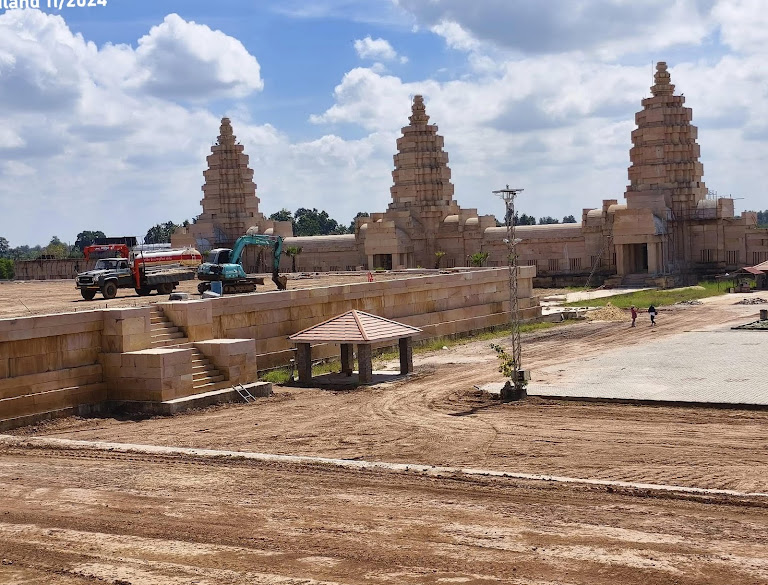Thailand temple triggers Cambodia’s Angkor W
cambodia July 11, 2025
Thailand temple triggers Cambodia’s Angkor Wat fury over cultural theftTemple spat exposes how nations weaponize culture, sparking a battle over identity and regional power in Southeast Asia.
The past isn’t history; it’s infrastructure. It’s the bedrock upon which nations build their identities, justify their claims, and wage their quiet wars. And like any infrastructure, it’s subject to strategic manipulation, even outright sabotage. Witness the escalating tension between Thailand and Cambodia over Wat Phu Man Fah, a new Buddhist temple in Buri Ram, Thailand. Cambodia alleges it’s an “unethical imitation” of Angkor Wat, their national treasure, a charge Thailand vehemently denies, citing political motivation, according to the Bangkok Post. This isn’t simply a dispute over architectural aesthetics; it’s a high-stakes battle for cultural legitimacy, fought on the neutral, yet politically charged, ground of a UNESCO World Heritage Committee session.
This isn’t just about bricks and mortar; it’s about legitimacy. Angkor Wat, a monumental 12th-century temple complex, isn’t merely a stunning architectural achievement; it’s the embodiment of Khmer identity and national pride, a tangible link to a glorious past. To label Wat Phu Man Fah a “blatant and unethical copy,” as Cambodia’s Minister of Culture and Fine Arts Phoeurng Sackona has, isn’t just an architectural critique; it’s an existential challenge. It implicitly devalues Cambodia’s unique cultural contribution, suggesting it’s easily replicable, and thus, less intrinsically valuable. It undermines the very foundation of their national narrative.
“Thailand firmly believes that cultural heritage should foster mutual understanding and cooperation — not division,"
But what constitutes an 'unethical imitation” in a world of constant cultural exchange? The accusation raises thorny questions about originality, influence, and the very nature of cultural evolution. Consider the long history of architectural appropriation: Roman architecture, steeped in Greek precedent; the Renaissance, a wholesale revival of classical forms; even the Gothic cathedrals of Europe drew inspiration from Islamic architectural innovations like pointed arches. Culture is a recombinant process; no society exists in a vacuum, and the flow of ideas and aesthetics is rarely unidirectional.
The core of the conflict, however, runs deeper than architectural similarities; it taps into the raw nerve of regional power dynamics. Thailand, with its economic might and greater geopolitical clout, has historically been seen as the dominant force in Southeast Asia. Cambodia, still scarred by the horrors of the Khmer Rouge and struggling to rebuild, clings to Angkor Wat as a symbol of its enduring resilience and cultural distinctiveness. Any perceived threat to that symbol, be it real or imagined, ignites a potent and protective nationalism. Think of post-Soviet states fiercely guarding their languages and traditions as bulwarks against renewed Russian influence.
This cultural skirmish illuminates a broader paradox of globalization: the more interconnected the world becomes, the more fiercely nations cling to their perceived cultural uniqueness. As Benedict Anderson argued in Imagined Communities, nations are “imagined” entities, forged through shared narratives and symbols. These symbols, like Angkor Wat, act as powerful anchors for national identity, particularly when confronted with the homogenizing forces of globalization. A perceived threat to these symbols becomes an assault on the very idea of the nation, prompting a visceral defense. Consider how France fiercely protects its language and culture through institutions like the Académie Française, a response to the perceived dominance of Anglo-American cultural influence.
The dispute also exposes the limitations of international bodies like UNESCO. While intended to foster cultural understanding and cooperation, they can also become instruments in geopolitical games. The accusation by Thai officials that Cambodia lobbied other member states highlights the strategic use — or misuse — of cultural heritage and intergovernmental organizations to advance narrow nationalistic agendas. The forum meant to preserve global heritage becomes just another theater for national competition.
Ultimately, the Wat Phu Man Fah controversy serves as a stark reminder that culture is never simply about art or history; it is a battleground. It highlights the weaponization of culture in an era of increasing global interconnectedness and resurgent nationalism. It’s a reminder that cultural heritage isn’t just about preserving the past, but about shaping the future — and that the more globalized we become, the more fiercely we will likely defend our localized identities, even if that defense takes the form of accusing a neighbor of architectural plagiarism. The question then becomes: in a world of constant cultural exchange, where do we draw the line between inspiration and theft, and who gets to draw it?
Khao24.com
cambodia, culture, geopolitics, nationalism
